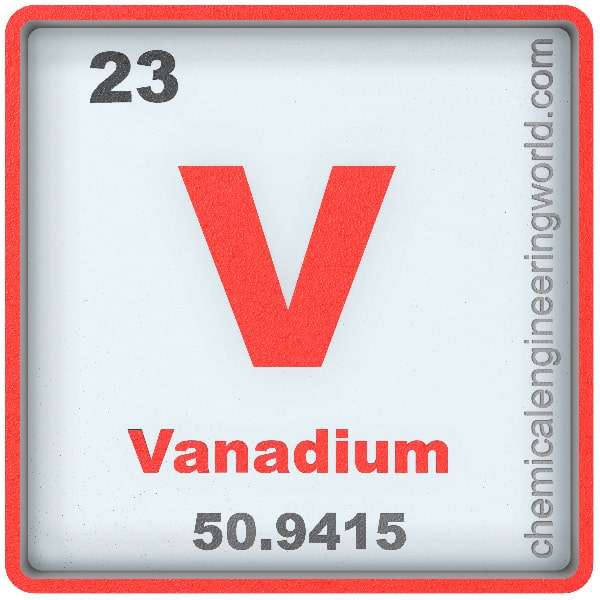Vanadium Element Properties and Information

Vanadium Element Properties and Information
Vanadium is the twenty-third element on the periodic table. Elements are arranged in the periodic table on the basis of the atomic number. Atomic number is the number of protons in the nucleus of the atom. Vanadium has an atomic number of 23. It is located in the Group 5 and Period 4 of the periodic table of elements. It is denoted by V. The name is derived from ‘Vanadis’ who is the Scandinavian goddess Freyja.
Andrés Manuel del Rio discovered vanadium in 1801 from a mineral called vanadite but he misjudged it as chromium. Nil Gabriel Selfström separated an unknown metal from an iron cast. The unknown metal was vanadium but it was not separated in pure form. Pure vanadium was produced by Henry Roscoe in 1869, he also showed that previously separated vanadium were actually vanadium nitride.
Vanadium is rarely found in nature in free state. It is present in about 65 different types of minerals. Some of these minerals are; vanadite, carnotite, and patronite. Apart from these minerals, vanadium is also found in some iron ores, phosphate rocks and crude oil.
Physical Properties
- Vanadium metal is silver-grey in colour. It is a hard, ductile and malleable transition metal.
- The atomic mass of vanadium is 50.941
- The melting point of vanadium is 1910°C
- The boiling point of vanadium is 3407°C
- The density of vanadium is 6100 in S.I. units at 20°C
- There are two naturally occurring isotopes of vanadium; vanadium-50 and vanadium-51. Among them; vanadium-50 is radioactive and vanadium-51 is stable.
- Vanadium is an electrical conductor but a thermal insulator.
- Vanadium has good corrosion resistance, it is quite stable against the attacks of sulphuric acid, hydrochloric acid and alkalis.
Chemical Properties
- If vanadium is exposed to air, a layer of oxide forms on the surface.
- Vanadium is oxidised in air at 660°C.
- Vanadium(II) compounds are reducing agents.
- Vanadium(IV) compounds exist as vanadyl derivatives.
- Vanadium(V) compounds are oxidising agents.
Methods of Production
- Reduction: The ore containing vanadium is first crushed and then roasted with sodium chloride at about 850°C to give sodium metavanadate. Aqueous extract of sodium metavanadate is acidified to give polyvanadate salts. The polyvanadate salts are then reduced to yield vanadium.
- Crystal bar process: It is a purification process for vanadium. In this process, vanadium is obtained in the form of vanadium(III) iodide and then this compound is decomposed.
Relevance in Chemical and Related Industries
- Metallurgy: Vanadium is usually used as a component in alloys. About 85% of vanadium produced is used to make ferrovanadium alloys or as steel additives. Vanadium is also added to titanium in order to increase the temperature stability and strength of titanium.
- Catalysts: Vanadium catalysts are used for producing many chemicals of commercial value. For example, oxides of vanadium used as catalysts for producing sulphuric acid, maleic anhydride, and phthalic anhydride.
- Glass and Ceramic industries: Vanadium dioxide is used as glass coating because it blocks the passage of infrared rays and simultaneously allows visible rays at certain temperatures. Vanadium pentoxide is used in ceramics.
Relevance in Other Industries
Battery: Vanadium redox batteries are used commercially for grid storage; they are a kind of electrochemical cell consisting of aqueous vanadium ions in different oxidation states.
Health Effects on Exposure
- Inhalation: When vanadium pentoxide dust is inhaled in small to moderate amounts then it causes irritation in the nasal cavity, in wind pipe and lungs.
- Overexposure: When vanadium is exposed to eyes then it can cause conjunctivitis, when large amounts goes inside nose then if causes nasopharyngitis, when it goes in lungs then it causes laboured breathing and lung changes, the tongue becomes allergic and skin develops rashes.
Effects on Surroundings
- Inhalation: Large quantities of vanadium inside the body of animals can cause lung, liver and kidney problems.
- Overexposure: Vanadium inhibits an important enzyme which aids in neurological well-being. Vanadium can cause harm to reproductive system of male animals and to the placenta of female animals.
References:
https://en.m.wikipedia.org/wiki/Vanadium
































